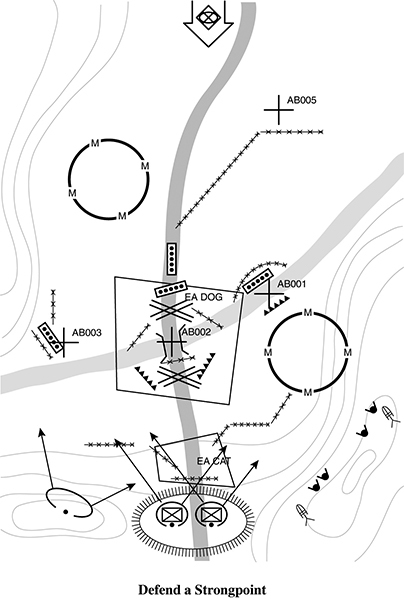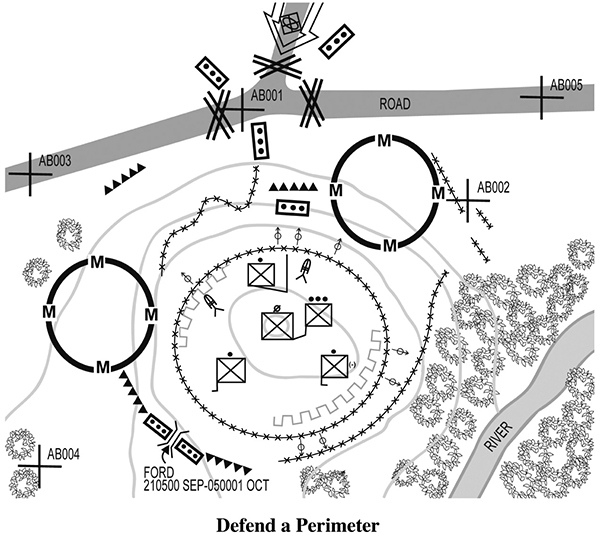Defend a Strongpoint
Defending a strongpoint is not a common mission for an infantry platoon. A strongpoint defense requires extensive engineer support (in terms of expertise, materials, and equipment) and takes a long time to complete. When the platoon is directed to defend a strongpoint, it must retain the position until ordered to withdraw. The success of the strongpoint defense depends on how well the position is tied into the existing terrain. This defense is most effective when it is employed in terrain that provides cover and concealment to both the strongpoint and its supporting obstacles. Mountainous, forested, or urban terrain can be adapted easily to a strongpoint defense. Strongpoints placed in more open terrain require the use of reverse slopes or extensive camouflage and deception efforts. This defensive mission may require the platoon to perform one or more of the following:
•Hold key or decisive terrain critical to the company or battalion scheme of maneuver.
•Provide a pivot to maneuver friendly forces.
•Block an avenue of approach.
•Canalize the enemy into one or more EAs.
The prime characteristic of an effective strongpoint is that it cannot be easily overrun or bypassed. It must be positioned and constructed so that the enemy knows he can reduce it only at the risk of heavy casualties and significant loss of materiel. Techniques and considerations involved in establishing and executing the strongpoint defense include:
•The projected size of the strongpoint versus available troops and equipment.
•Routes in and out.
•Placement of antiarmor weapons in and outside the defense.
•Availability of 360-degree observation.
•Number of needed EAs.
•Placement and use of platoon reserve.
•Best use of internal squad battle positions.
Engineers support a strongpoint defense by reinforcing the existing obstacles. Priorities of work will vary depending on the factors of METT-TC, especially the enemy situation and time available. For example, the first twelve hours of the strongpoint construction effort may be critical for emplacing countermobility and survivability positions and C2 bunkers. On the other hand, if the focus of engineer support is to make the terrain approaching the strongpoint impassable, the battalion engineer effort must be adjusted accordingly.

Defend a Perimeter
A perimeter defense allows the defending force to orient in all directions. In terms of weapons emplacement, direct- and indirect-fire integration, and reserve employment, a platoon leader conducting a perimeter defense should consider the same factors as a strongpoint operation.
1.The perimeter defense allows only limited maneuver and limited depth. Nonetheless, the platoon may be called on to execute a perimeter defense under a variety of conditions that include:
•Holding critical terrain in areas where the defense is not tied in with adjacent units.
•Defending in place when it has been bypassed and isolated by the enemy.
•Conducting occupation of an independent avenue of approach (AA) or reserve position.
•Preparing a strongpoint.
•Concentrating fires in two or more adjacent avenues of approach.
•Defending CS or CSS assets.
•Occupying a patrol base.

2.The major advantage of the perimeter defense is the platoon’s ability to defend against an enemy avenue of approach. A perimeter defense differs from other defenses in that:
•The trace of the platoon is circular or triangular rather than linear.
•Unoccupied areas between squads are smaller.
•Flanks of squads are bent back to conform to the plan.
•The bulk of combat power is on the perimeter.
•The reserve is centrally located.
Note: A variant of the perimeter defense is the use of the shaped defense, which allows two of the platoon’s squads to orient at any particular time on any of three EAs.
Reverse Slope Defense
The platoon leader’s analysis of the factors of METT-TC often leads him to employ his forces on the reverse slope. If the rifle squads are on a mounted avenue of approach, they must be concealed from enemy direct-fire systems. This means rifle squads should be protected from enemy tanks and observed artillery fire. Some reverse slope defense considerations are:
1.The majority of a rifle squad’s weapons are not effective beyond 600 meters. To reduce or preclude destruction from enemy direct and indirect fires beyond that range, a reverse slope defense should be considered. In some cases, it may be necessary for these weapons systems to be deployed forward while the rifle squads remain on the reverse slope (to take advantage of their long ranges). The Javelins withdraw from their forward positions as the battle closes. Their new positions should be selected to take advantage of their long-range fires and to get enfilade shots from the depth and the flanks of the reverse slope.
2.The nature of the enemy may change at night, and the rifle squads may occupy the forward slope or crest to deny it to the enemy. In those circumstances, it is feasible for a rifle squad to have an alternate night position forward. The area forward of the topographical crest must be controlled by friendly forces through aggressive patrolling and both active and passive reconnaissance measures.
3.The company commander normally makes the decision to position platoons on a reverse slope when:
•He wishes to surprise or deceive the enemy about the location of his defensive position.
•A forward slope might be made untenable by direct enemy fire.
•Occupation of the forward slope is not essential to achieve depth and mutual support.

•Fields of fire on the reverse slope are better or at least sufficient to accomplish the mission.
•Forward slope positions are likely to be the target of concentrated enemy artillery fires.
Obstacles are necessary in a reverse slope defense. Since the enemy will be engaged at close range, obstacles should prevent the enemy from closing too quickly and overrunning the positions. Obstacles on the reverse slope can halt, disrupt, and expose enemy vehicles to flank AT fires. They should also facilitate the platoon’s disengagement.
Reorganization in Combat
Reorganization begins automatically at team and squad levels during the battle to prepare for the next battle. To prepare for the next attack, the platoon should accomplish the following tasks:
Man Key Weapons. Replace key soldiers lost during battle. For example, ensure that crew-served weapons are manned and new team leaders are designated.
Reestablish Security. If soldiers withdrew from the OPs to their fighting positions, return them to their OPs. If some did not get back to their positions, check their status and replace casualties. As soon as possible, reestablish the sleep-alert system.
Treat and/or Evacuate Casualties. Treat casualties as far forward as possible. Return those who can continue to fight to their positions; evacuate the others.
Redistribute Ammunition and Supplies. Distribute remaining ammunition and supplies equally among the soldiers, including ammunition from the casualties.
Relocate Fighting Positions and Weapons Positions. During the assault, the enemy may have pinpointed some of the fighting and weapons positions. If certain positions are in danger, move soldiers and weapons (especially crew-served weapons) to their alternate positions.